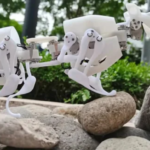News, Legged Robot SQuRo Mimics Real Rat Motions in Narrow Spaces
In the past, scientists have struggled to design quadruped robots that are both adaptable and able to fit into narrow spaces. To combat this issue, a team of researchers have taken rats as their source of inspiration for a new tiny biomimetic robot capable of executing various actions and carrying payloads, due to their agility and adaptability.
A team from the Beijing Institute of Technology in China has developed the SQuRo (small-sized quadruped robotic rat), a robot that can mimic the movement and behavior of biological systems by spending a lot of time mimicking specific traits and functions.
Scientists created a wheeled robotic rat that can perform a variety of rodent-like activities using bioinspired design. Researchers chose to replace the wheels with legs to improve movement agility even further. Experiments show that the legged robot SQuRo can simulate the movements of real rats in small places, according to the findings of this study.
Rats’ extended slim form and unrivaled agility allow them to adapt to narrow spaces. As a result, researchers make extensive use of the morphology and motion features of rats moving in caves to mimic movement agility. SQuRo can execute numerous actions, including crouching-to-standing, crawling, walking and turning, and can recover from a fall by regulating its limbs and cervical components to suitably shift its center of mass (CoM), because of its biomimetic flexible construction and multimodal motion control.
Furthermore, SQuRo demonstrated its potential applicability to inspection jobs within narrow spaces by passing through an irregular narrow tunnel (inner width of 90 mm), crossing a 30 mm high barrier, and maintaining steady locomotion on a 15° incline slope in field testing.
When compared to small-sized quadruped robots, SQuRo can maintain stable locomotion even when carrying a payload equivalent to 91% of its weight, demonstrating its better payload-carrying capabilities. These skills enable SQuRo to navigate through narrow spaces and rough terrains while performing activities like detection and transportation in applicable settings.
Learn about our two Decals!
 Click here to find out more about our Fall Bioinspired Design Decal and our Spring Bioinspired Design in Action Decal – ALL MAJORS are welcome.
Click here to find out more about our Fall Bioinspired Design Decal and our Spring Bioinspired Design in Action Decal – ALL MAJORS are welcome.Berkeley BioDesign Community
 Click here to learn about the BioD: Bio-Inspired Design @ Berkeley student organization or here to signup for more info.
Click here to learn about the BioD: Bio-Inspired Design @ Berkeley student organization or here to signup for more info.Search
Student Login




I imagine that the neurological circuits underlying these processes are governed by both 2d spacing maps with their brains as…
to reduce the impact of car accidents, it may be possible to study the force diverting physics of cockroaches to…
you see this type of head-bobbing stability in many avian creatures related to pigeons like chickens. the head ability to…
not like they taught horses how to run! this is an example of convergent evolution where both sea creatures and…
The brain functions in a similar way with neuronal connections. our brains are able to utilize the multiplicity of connections…